TITLE
Rendering a triangle with The Forge
DESCRIPTION
Guide to setting up a minimal example with The Forge Framework.
CREATED
Tue Mar 18 2025 04:21:00 GMT+0000 (Coordinated Universal Time)
LAST MODIFIED
Sat May 24 2025 10:05:06 GMT+0000 (Coordinated Universal Time)
POST
After implementing my own renderer from scratch with Vulkan, I think it’s time to move on to using something a bit higher level. I decided to try out The Forge by ConfettiFX. Unfortunately, the documentation is rather lacking, and the examples are really the only resources available for learning it.
There is a guide on building The Forge by LCG, but it’s outdated and didn’t work for me. I managed to get a triangle rendered on the screen after a few hours of tinkering. In this post, I’ll share the steps I took, to help others like me get started with the framework.
This guide is mainly geared towards people with experience in Vulkan, or any of the modern graphics APIs.
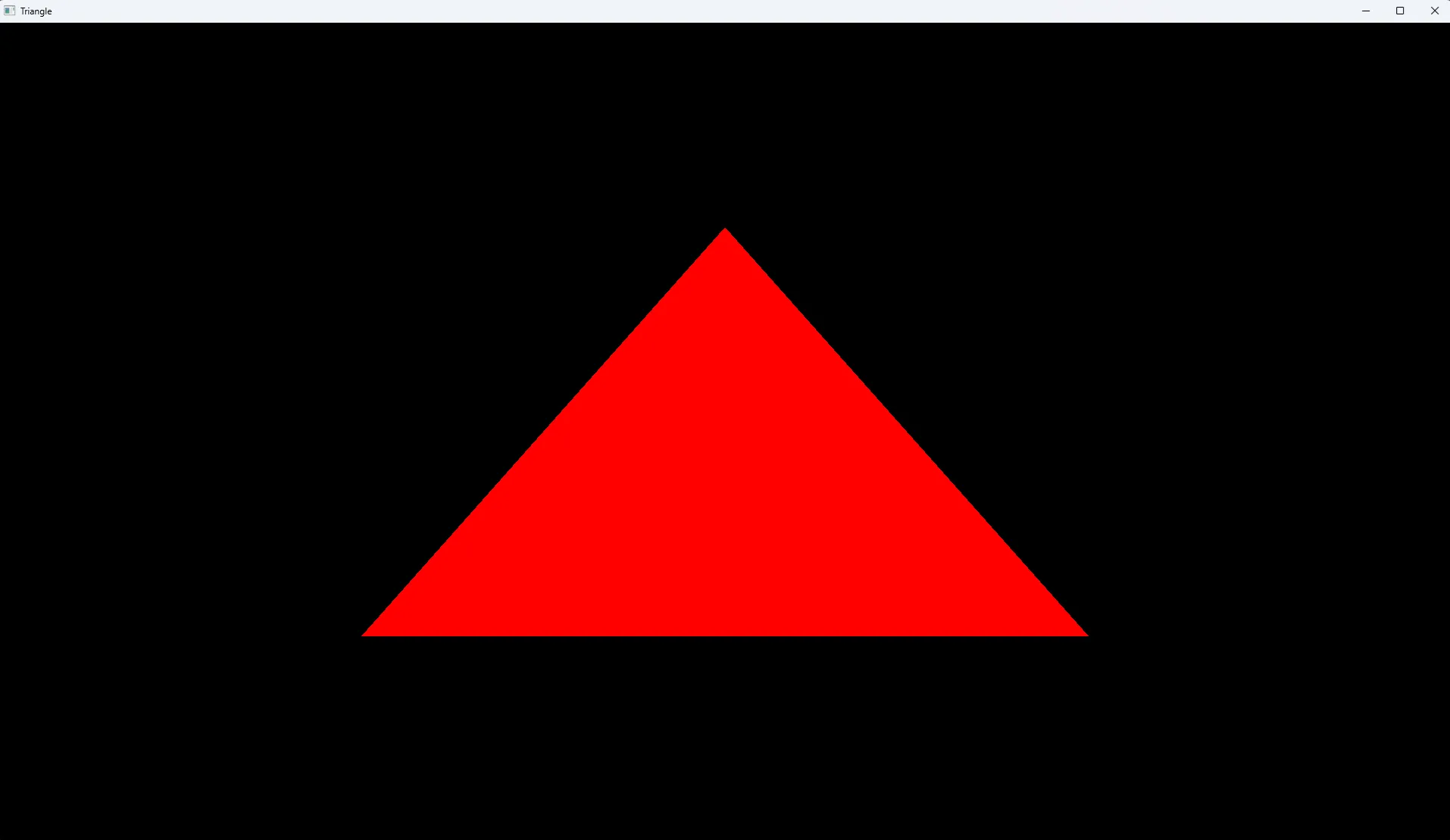
Prerequisites (Windows)
TL;DR: Download Visual Studio 2019 version 16.10 here, select and install “Desktop development with C++” package and Windows 10 SDK (10.0.17763.0).
ConfettiFX provides IDE project files for the supported platforms, and since I use Windows, that will be Visual Studio.
The Forge is only tested on Visual Studio 2019 with Windows SDK 10.0.17763.0, so that’s what we’re going to use. If we take a look at Application/Config.h, it specifically wants _MSC_VER == 1929, which is Visual Studio 2019 version 16.10.
// Whitelist of compiler versions#if (_MSC_VER == 1929) // VS 2019 all VC++ compilers#else#pragma message("Bad Visual Studio version: (" QUOTE(_MSC_VER) " " QUOTE(_MSC_FULL_VER) " " QUOTE(_MSC_BUILD) ").")#error "Bad Visual Studio version"#endifI used Wayback Machine to access the Visual Studio download page from June 1st, 2021, downloaded and installed it with the required Windows SDK version.
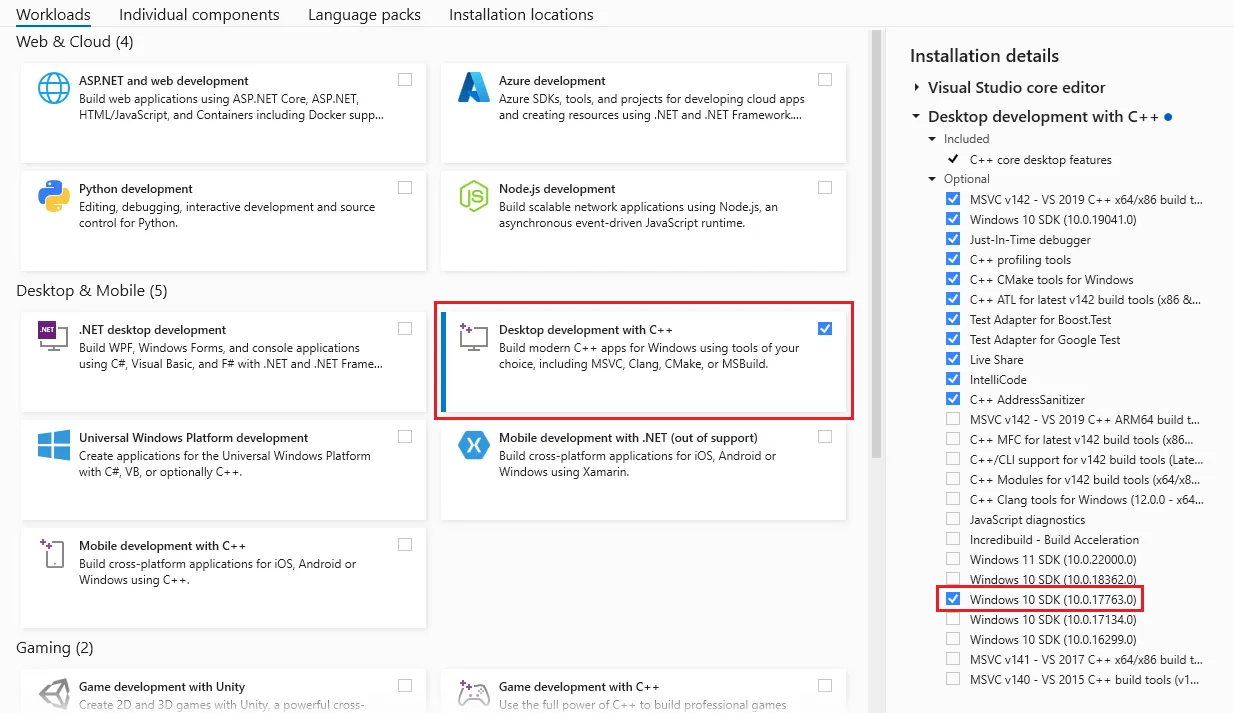
Cloning and building The Forge
Before we try to do anything with the framework, let’s make sure we can actually run it. First clone the repository:
git clone https://github.com/ConfettiFX/The-Forge.gitTo run the examples, you have to download the assets used by them by running the PRE_BUILD.bat file. Then open The-Forge\Examples_3\Unit_Tests\PC Visual Studio 2019\Unit_Tests.sln. Set 01_Transformations as the Startup Project in the Solution Explorer.
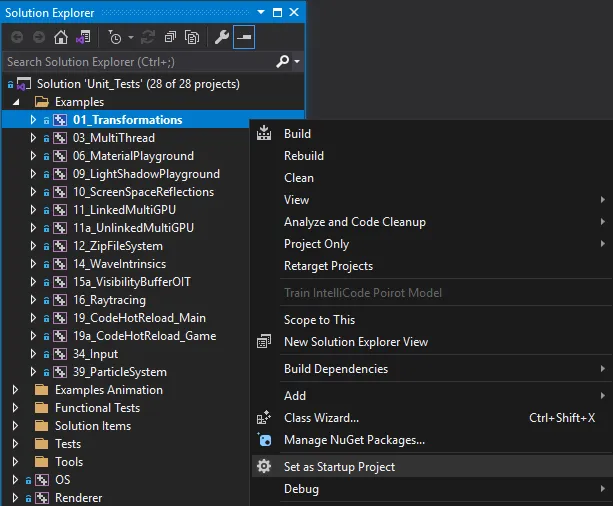
Then launch by clicking on Local Windows Debugger. If everything went well the following window with the solar system should open.
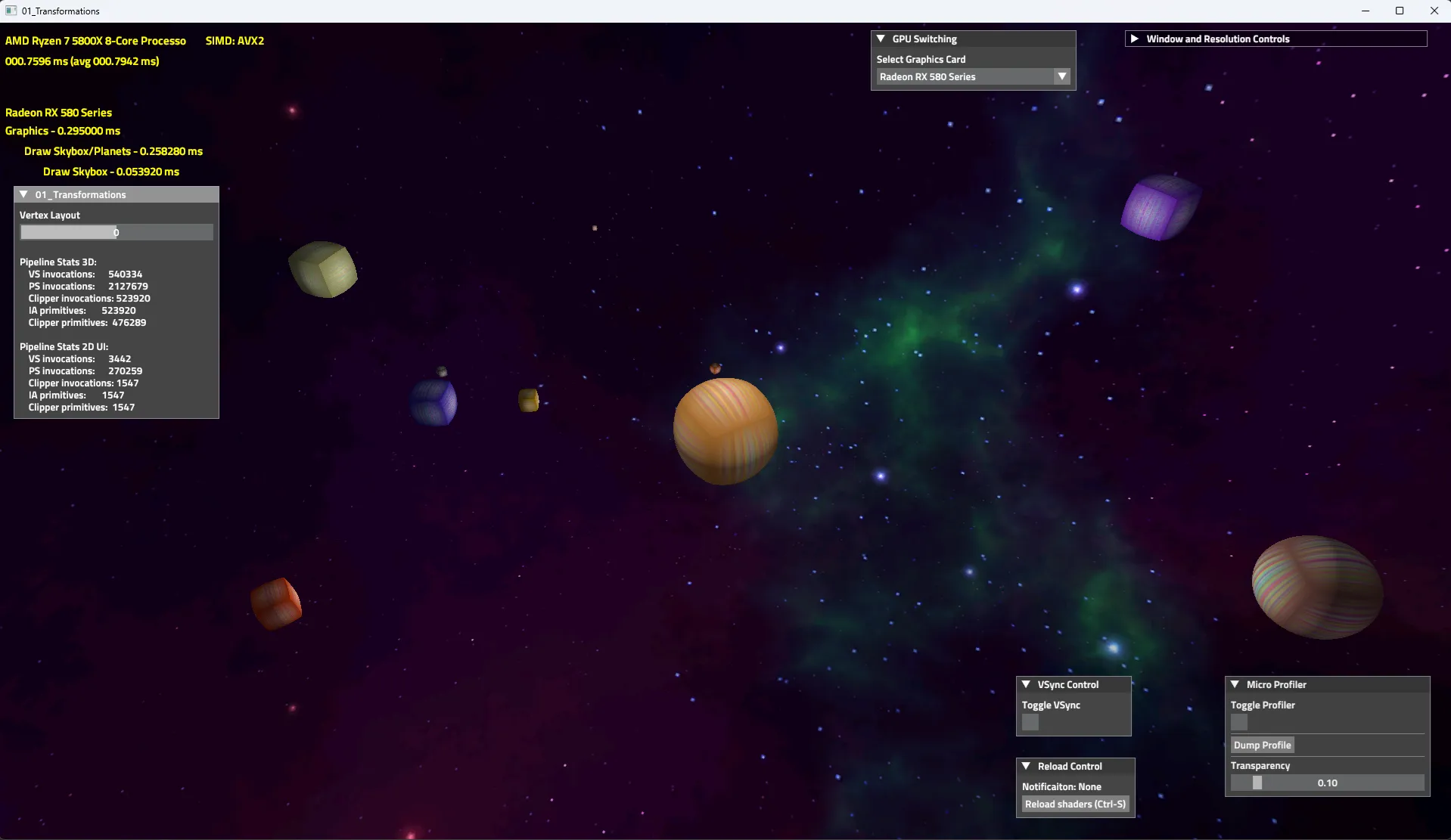
Now we’re ready to create our triangle project.
Creating a new project
In Solution Explorer, create a new project by right clicking Examples, and select Add/New Project.

Select the Empty Project template, name the project triangle and put it in the PC Visual Studio 2019 directory.
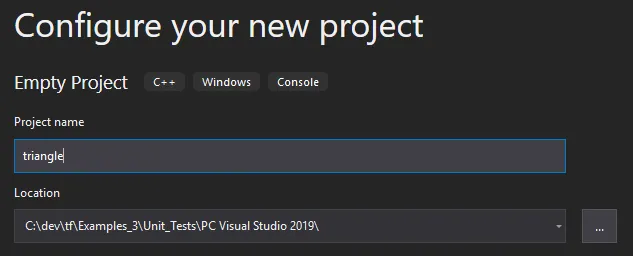
Visual Studio will create a new directory for our project, but we want our project files to be in the same directory as the other examples (otherwise we’ll have to adjust some paths). First remove the project in Visual Studio:

Then copy the project files to the same directory as the other examples and delete the original triangle directory

Then add as an existing project

Now let’s add a source file. Right click on Source Files and select Add/New Item.

Create a new directory triangle under Unit_Tests\src and put your source file there. I named mine triangle.cpp.

Put the following code in triangle.cpp. Adjust the include path if you need to.
#include "../../../../Common_3/Application/Interfaces/IApp.h"
class Triangle : public IApp{ bool Init() override { return true; }
void Exit() override {
}
bool Load(ReloadDesc* pReloadDesc) override { (void)pReloadDesc; return true; }
void Unload(ReloadDesc* pReloadDesc) override { (void)pReloadDesc; }
void Update(float deltaTime) override { (void)deltaTime; }
void Draw() override {
}
const char* GetName() override { return "Triangle"; }};
DEFINE_APPLICATION_MAIN(Triangle)We’ll need to configure our new project. Right click on the project and select Properties.
In Configuration Properties/General, set Output Directory to:
$(SolutionDir)$(Platform)\$(Configuration)\$(ProjectName)\And set Intermediate Directory to:
$(SolutionDir)\$(Platform)\$(Configuration)\Intermediate\$(ProjectName)\Make sure that the correct version of Visual Studio and Windows SDK are selected.
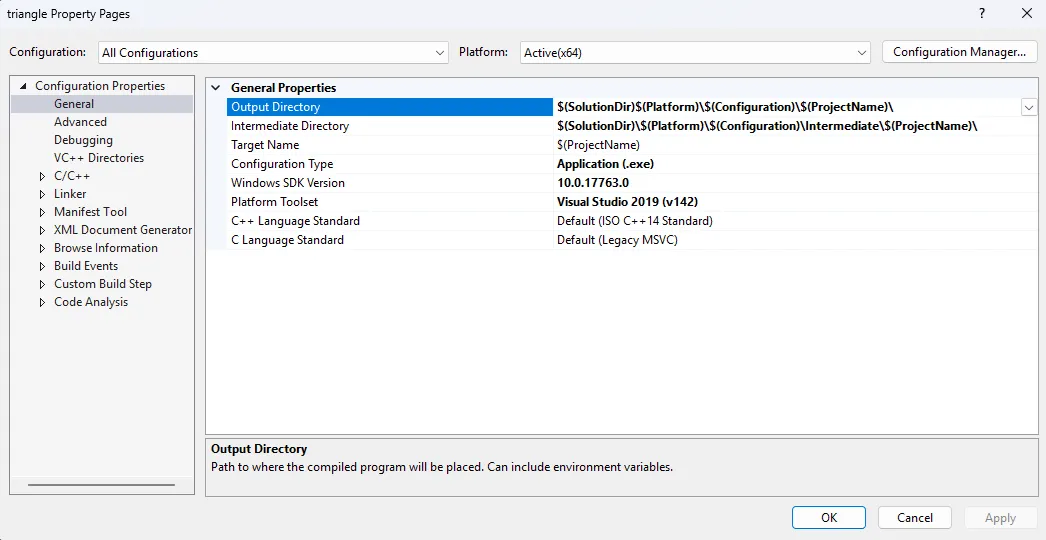
In Configuration Properties/Debugging, set Working Directory to $(OutDir)

In Configuration Properties/VC++ Directories, set Library Directories to:
$(SolutionDir)\$(Platform)\$(Configuration);$(LibraryPath)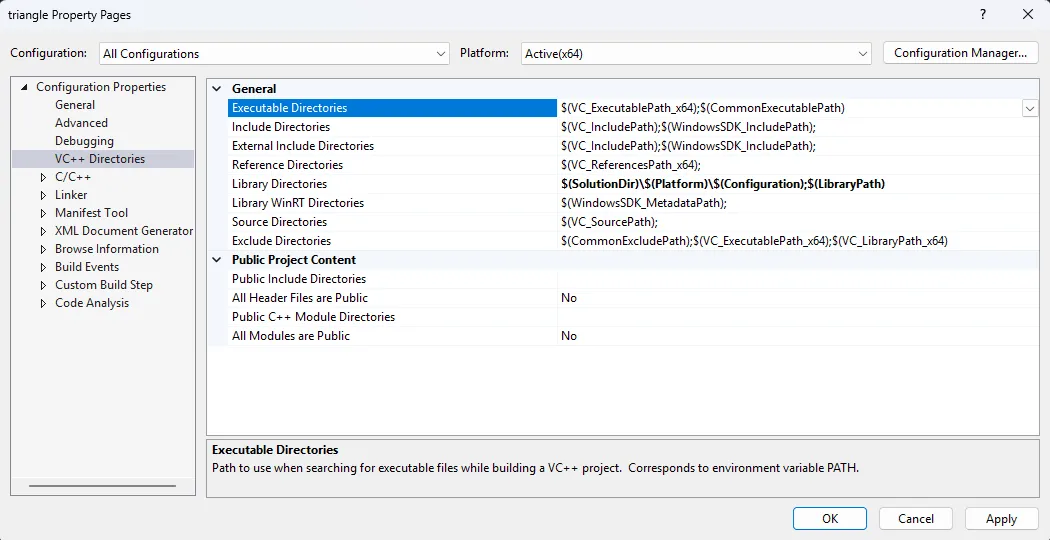
In Configuration Properties/Linker/Input, set Additional Dependencies to:
Xinput9_1_0.lib;ws2_32.lib;Renderer.lib;OS.lib;%(AdditionalDependencies)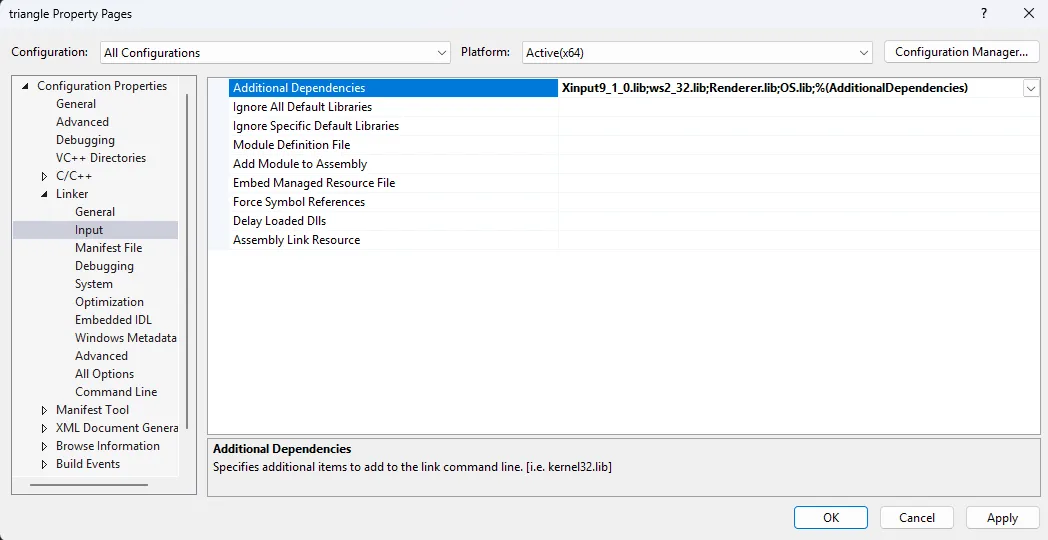
We also need to set the build dependencies. Right click on the project, select Build Dependencies/Project Dependencies.
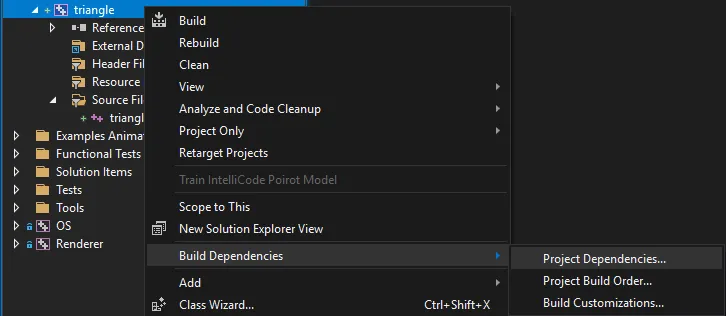
Select OS and Renderer
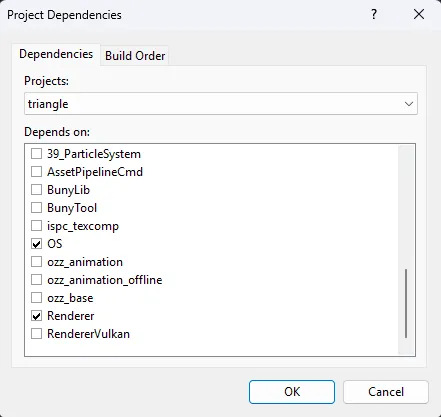
Now, this error will appear if we try to build:
![]()
The examples define D3D12_AGILITY_SDK_VERSION in Examples_3\Build_Props\VS\TF_Shared.props.
<PreprocessorDefinitions> D3D12_AGILITY_SDK=1; D3D12_AGILITY_SDK_VERSION=715; %(PreprocessorDefinitions)</PreprocessorDefinitions>TF_Shared.props also imports a platform-specific .props that contains the commands to copy the required resources to the build directory, and a command that launches the shader reload server.
<ImportGroup Label="PropertySheets"> <Import Condition="$(ProjectDir.Contains('Quest_VisualStudio2019'))" Project="$(TheForgeRoot)Examples_3\Build_Props\VS\Quest.arm64.v8a.props" /> <Import Condition="$(ProjectDir.Contains('Android_VisualStudio2019'))" Project="$(TheForgeRoot)Examples_3\Build_Props\VS\Android.arm64.v8a.props" /> <Import Condition="$(ProjectDir.Contains('PC Visual Studio 2019'))" Project="$(TheForgeRoot)Examples_3\Build_Props\VS\Examples.x64.props" /> <Import Condition="$(ProjectDir.Contains('PS4 Visual Studio 2019'))" Project="$(TheForgeRoot)PS4\VSProps\PS4.props" /> <Import Condition="$(ProjectDir.Contains('Prospero Visual Studio 2019'))" Project="$(TheForgeRoot)Prospero\VSProps\Prospero.props" /> <Import Condition="$(ProjectDir.Contains('NX'))" Project="$(TheForgeRoot)Switch\Examples_3\Unit_Tests\NX Visual Studio 2019\ImportNintendoSdk.props" /></ImportGroup>On Windows, the imported .props is Examples.x64.props
<ItemDefinitionGroup Condition="'$(ConfigurationType)' == 'Application'"> <PostBuildEvent> <Command> xcopy "$(TheForgeRoot)Common_3\Graphics\ThirdParty\OpenSource\VulkanSDK\bin\Win32\*.dll" "$(OutDir)" /S /Y /D xcopy "$(TheForgeRoot)Common_3\Graphics\ThirdParty\OpenSource\VulkanSDK\bin\Win32\*.json" "$(OutDir)" /S /Y /D xcopy "$(TheForgeRoot)Common_3\Graphics\ThirdParty\OpenSource\ags\ags_lib\lib\amd_ags_x64.dll" "$(OutDir)amd_ags_x64.dll"* /S /Y /D xcopy "$(TheForgeRoot)Common_3\Graphics\ThirdParty\OpenSource\DirectXShaderCompiler\bin\x64\dxcompiler.dll" "$(OutDir)dxcompiler.dll"* /S /Y /D xcopy "$(TheForgeRoot)Common_3\Graphics\ThirdParty\OpenSource\Direct3d12Agility\bin\x64\*.dll" "$(OutDir)"* /S /Y /D xcopy "$(TheForgeRoot)Common_3\Graphics\ThirdParty\OpenSource\winpixeventruntime\bin\WinPixEventRuntime.dll" "$(OutDir)WinPixEventRunTime.dll"* /S /Y /D xcopy /Y /D "$(TheForgeArtDir)PathStatement.Windows.txt" "$(OutDir)PathStatement.txt*" xcopy /Y /D "..\src\$(ProjectName)\GPUCfg\gpu.cfg" "$(OutDir)"
mkdir "$(OutDir)PipelineCaches\" mkdir "$(OutDir)Screenshots\" mkdir "$(OutDir)Debug\" mkdir "$(OutDir)Scripts\" xcopy /Y /D "..\src\$(ProjectName)\Scripts\*" "$(OutDir)\Scripts\" xcopy "$(TheForgeRoot)Common_3\Scripts\*" "$(OutDir)\Scripts\" /Y /D
xcopy "$(TheForgeRoot)Common_3\OS\Windows\pc_gpu.data" "$(OutDir)gpu.data*" /Y /D
cd "$(TheForgeRoot)" powershell start-process ".\Common_3\Tools\ReloadServer\ReloadServer.bat" -WindowStyle Hidden </Command> </PostBuildEvent> <PreLinkEvent> <Command> if exist "$(OutDir)..\OS\Shaders\" xcopy /Y /S /D "$(OutDir)..\OS\Shaders\*" "$(OutDir)Shaders\" if exist "$(OutDir)..\OS\CompiledShaders\" xcopy /Y /S /D "$(OutDir)..\OS\CompiledShaders\*" "$(OutDir)CompiledShaders\" </Command> </PreLinkEvent></ItemDefinitionGroup>We can define these ourself, but for this project we’re just going to use the provided TF_Shared.props file. Edit triangle.vcxproj and add these lines just before the last </Project> line. Adjust the path to TF_Shared.props if you need to.
<ImportGroup Label="PropertySheets"> <Import Project="..\..\..\Examples_3\Build_Props\VS\TF_Shared.props" /></ImportGroup>If you pay close attention, you’ll notice that we’re missing the
gpu.cfgfile. It’s not strictly necessary, so it’s not going to be a problem for us.
Reload the project, set it as the startup project and launch. If everything went well a window should pop up.

Now we can start writing the code for our triangle.
Rendering a triangle
The Forge uses FSL (Forge Shading Language). We first need to integrate FSL by right clicking the project, select Build Dependencies/Build Customizations and choose the fsl.target file.
Now we can start writing the shaders for our triangle. First create a new filter for our shaders and name it FSLShaders
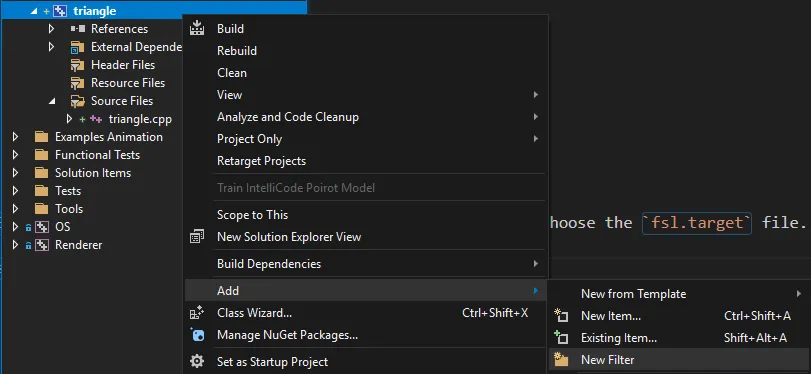
Then right click on FSLShaders and select Add/New Item.

Create a new directory Shaders under Unit_Tests\src\triangle and place your shaders there, making sure it ends with .fsl. I named mine triangle.vert.fsl and triangle.frag.fsl. Also add a new file shaders.list in the same directory.

Put the following code in triangle.vert.fsl. Refer to the FSL Programming Guide for more details.
STRUCT(VSInput){ DATA(float4, Position, POSITION);};
STRUCT(VSOutput){ DATA(float4, Position, SV_Position);};
ROOT_SIGNATURE(DefaultRootSignature)VSOutput VS_MAIN(VSInput In){ INIT_MAIN; VSOutput Out;
Out.Position = float4(In.Position.x, In.Position.y, In.Position.z, In.Position.w); RETURN(Out);}Put this in triangle.frag.fsl
STRUCT(VSOutput){ DATA(float4, Position, SV_Position);};
ROOT_SIGNATURE(DefaultRootSignature)float4 PS_MAIN(VSOutput In){ INIT_MAIN; float4 Out;
Out = float4(1.0, 0.0, 0.0, 1.0); RETURN(Out);}And put this in shaders.list. Adjust the include path if needed.
#include "../../../../../Common_3/Graphics/FSL/defaults.h"
#rootsig default.rootsig#end
#rootsig compute.rootsig#end
#vert triangle.vert#include "triangle.vert.fsl"#end
#frag triangle.frag#include "triangle.frag.fsl"#endRight click on the project and select Properties. In Configuration Properties/FSLShader:
- set
LanguagetoDIRECT3D12 - set
OutDirto$(OutDir)Shaders - set
BinaryOutDirto$(OutDir)CompiledShaders - set
Compile shader after generationtoYes
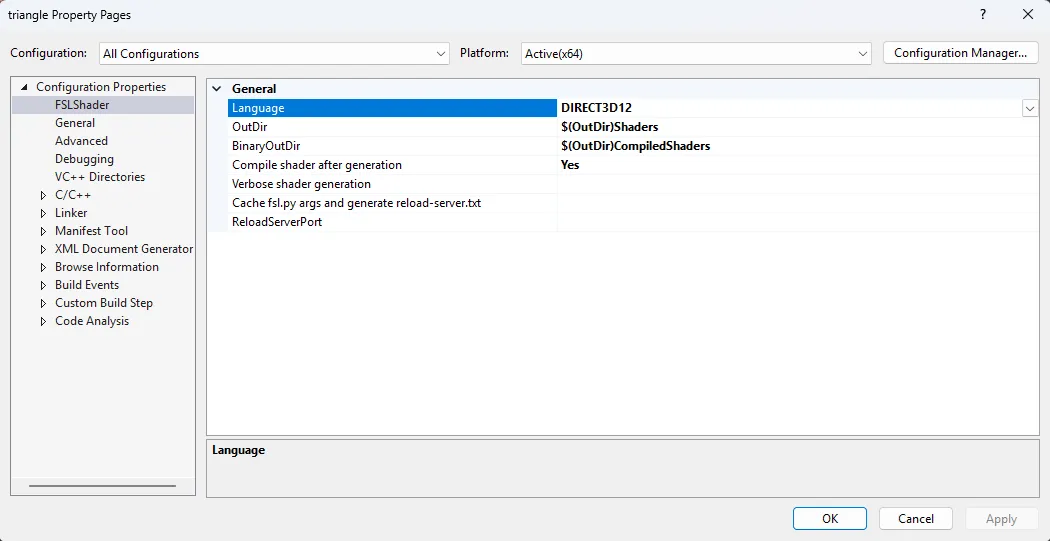
Now put this in triangle.cpp. If you’ve used Vulkan then this should look pretty familiar.
// Interfaces#include "../../../../Common_3/Application/Interfaces/IApp.h"
#include "../../../../Common_3/Utilities/RingBuffer.h"
// Renderer#include "../../../../Common_3/Graphics/Interfaces/IGraphics.h"#include "../../../../Common_3/Resources/ResourceLoader/Interfaces/IResourceLoader.h"
// FSL#include "../../../../Common_3/Graphics/FSL/defaults.h"
Renderer* pRenderer = NULL;Queue* pGraphicsQueue = NULL;GpuCmdRing gGraphicsCmdRing = {};
SwapChain* pSwapChain = NULL;Semaphore* pImageAcquiredSemaphore = NULL;
Shader* pTriangleShader = NULL;Buffer* pTriangleVertexBuffer = NULL;Pipeline* pTrianglePipeline = NULL;
const uint32_t gFramesInFlight = 2;
const float gTrianglePoints[] = { -0.5f, -0.5f, 0.0f, 1.0f, 0.5f, -0.5f, 0.0f, 1.0f, 0.0f, 0.5f, 0.0f, 1.0f,};
class Triangle : public IApp{ bool Init() override { RendererDesc settings; memset(&settings, 0, sizeof(settings)); initGPUConfiguration(settings.pExtendedSettings); initRenderer(GetName(), &settings, &pRenderer);
if (!pRenderer) { ShowUnsupportedMessage("Failed to Initialize renderer!"); return false; } setupGPUConfigurationPlatformParameters(pRenderer, settings.pExtendedSettings);
QueueDesc queueDesc = {}; queueDesc.mType = QUEUE_TYPE_GRAPHICS; queueDesc.mFlag = QUEUE_FLAG_INIT_MICROPROFILE; initQueue(pRenderer, &queueDesc, &pGraphicsQueue);
GpuCmdRingDesc cmdRingDesc = {}; cmdRingDesc.pQueue = pGraphicsQueue; cmdRingDesc.mPoolCount = gFramesInFlight; cmdRingDesc.mCmdPerPoolCount = 1; cmdRingDesc.mAddSyncPrimitives = true; initGpuCmdRing(pRenderer, &cmdRingDesc, &gGraphicsCmdRing);
initSemaphore(pRenderer, &pImageAcquiredSemaphore);
initResourceLoaderInterface(pRenderer);
RootSignatureDesc rootDesc = {}; INIT_RS_DESC(rootDesc, "default.rootsig", "compute.rootsig"); initRootSignature(pRenderer, &rootDesc);
uint64_t triangleDataSize = 4 * 3 * sizeof(float); BufferLoadDesc triangleVbDesc = {}; triangleVbDesc.mDesc.mDescriptors = DESCRIPTOR_TYPE_VERTEX_BUFFER; triangleVbDesc.mDesc.mMemoryUsage = RESOURCE_MEMORY_USAGE_GPU_ONLY; triangleVbDesc.mDesc.mSize = triangleDataSize; triangleVbDesc.pData = gTrianglePoints; triangleVbDesc.ppBuffer = &pTriangleVertexBuffer; addResource(&triangleVbDesc, NULL);
waitForAllResourceLoads();
return true; }
void Exit() override { removeResource(pTriangleVertexBuffer);
exitGpuCmdRing(pRenderer, &gGraphicsCmdRing); exitSemaphore(pRenderer, pImageAcquiredSemaphore);
exitRootSignature(pRenderer); exitResourceLoaderInterface(pRenderer);
exitQueue(pRenderer, pGraphicsQueue);
exitRenderer(pRenderer); exitGPUConfiguration(); pRenderer = NULL; }
bool Load(ReloadDesc* pReloadDesc) override { if (pReloadDesc->mType & RELOAD_TYPE_SHADER) { addShaders(); }
if (pReloadDesc->mType & (RELOAD_TYPE_RESIZE | RELOAD_TYPE_RENDERTARGET)) { if (!addSwapChain()) { return false; } }
if (pReloadDesc->mType & (RELOAD_TYPE_SHADER | RELOAD_TYPE_RENDERTARGET)) { addPipelines(); }
return true; }
void Unload(ReloadDesc* pReloadDesc) override { waitQueueIdle(pGraphicsQueue);
if (pReloadDesc->mType & (RELOAD_TYPE_SHADER | RELOAD_TYPE_RENDERTARGET)) { removePipelines(); }
if (pReloadDesc->mType & RELOAD_TYPE_SHADER) { removeShaders(); }
if (pReloadDesc->mType & (RELOAD_TYPE_RESIZE | RELOAD_TYPE_RENDERTARGET)) { removeSwapChain(pRenderer, pSwapChain); } }
void Update(float deltaTime) override { (void)deltaTime; }
void Draw() override { if ((bool)pSwapChain->mEnableVsync != mSettings.mVSyncEnabled) { waitQueueIdle(pGraphicsQueue); ::toggleVSync(pRenderer, &pSwapChain); }
uint32_t swapchainImageIndex; acquireNextImage(pRenderer, pSwapChain, pImageAcquiredSemaphore, NULL, &swapchainImageIndex);
RenderTarget* pRenderTarget = pSwapChain->ppRenderTargets[swapchainImageIndex]; GpuCmdRingElement elem = getNextGpuCmdRingElement(&gGraphicsCmdRing, true, 1);
FenceStatus fenceStatus; getFenceStatus(pRenderer, elem.pFence, &fenceStatus); if (fenceStatus == FENCE_STATUS_INCOMPLETE) { waitForFences(pRenderer, 1, &elem.pFence); }
resetCmdPool(pRenderer, elem.pCmdPool);
Cmd* cmd = elem.pCmds[0]; beginCmd(cmd);
RenderTargetBarrier barriers[] = { {pRenderTarget, RESOURCE_STATE_PRESENT, RESOURCE_STATE_RENDER_TARGET}, }; cmdResourceBarrier(cmd, 0, NULL, 0, NULL, 1, barriers);
BindRenderTargetsDesc bindRenderTargets = {}; bindRenderTargets.mRenderTargetCount = 1; bindRenderTargets.mRenderTargets[0] = {pRenderTarget, LOAD_ACTION_CLEAR }; cmdBindRenderTargets(cmd, &bindRenderTargets); cmdSetViewport(cmd, 0.0f, 0.0f, (float)pRenderTarget->mWidth, (float)pRenderTarget->mHeight, 0.0f, 1.0f); cmdSetScissor(cmd, 0, 0, pRenderTarget->mWidth, pRenderTarget->mHeight);
const uint32_t triangleVbStride = sizeof(float) * 4; cmdBindPipeline(cmd, pTrianglePipeline); cmdBindVertexBuffer(cmd, 1, &pTriangleVertexBuffer, &triangleVbStride, NULL); cmdDraw(cmd, 3, 0);
barriers[0] = { pRenderTarget, RESOURCE_STATE_RENDER_TARGET, RESOURCE_STATE_PRESENT }; cmdResourceBarrier(cmd, 0, NULL, 0, NULL, 1, barriers);
endCmd(cmd);
Semaphore* waitSemaphores[] = { pImageAcquiredSemaphore };
QueueSubmitDesc submitDesc = {}; submitDesc.mCmdCount = 1; submitDesc.mSignalSemaphoreCount = 1; submitDesc.mWaitSemaphoreCount = TF_ARRAY_COUNT(waitSemaphores); submitDesc.ppCmds = &cmd; submitDesc.ppSignalSemaphores = &elem.pSemaphore; submitDesc.ppWaitSemaphores = waitSemaphores; submitDesc.pSignalFence = elem.pFence; queueSubmit(pGraphicsQueue, &submitDesc);
QueuePresentDesc presentDesc = {}; presentDesc.mIndex = (uint8_t)swapchainImageIndex; presentDesc.mWaitSemaphoreCount = 1; presentDesc.pSwapChain = pSwapChain; presentDesc.ppWaitSemaphores = &elem.pSemaphore; presentDesc.mSubmitDone = true;
queuePresent(pGraphicsQueue, &presentDesc); }
const char* GetName() override { return "Triangle"; }
void addPipelines() { VertexLayout triangleVertexLayout = {}; triangleVertexLayout.mBindingCount = 1; triangleVertexLayout.mBindings[0].mStride = sizeof(float4); triangleVertexLayout.mAttribCount = 1; triangleVertexLayout.mAttribs[0].mSemantic = SEMANTIC_POSITION; triangleVertexLayout.mAttribs[0].mFormat = TinyImageFormat_R32G32B32A32_SFLOAT; triangleVertexLayout.mAttribs[0].mBinding = 0; triangleVertexLayout.mAttribs[0].mLocation = 0; triangleVertexLayout.mAttribs[0].mOffset = 0;
RasterizerStateDesc rasterizerStateDesc = {}; rasterizerStateDesc.mCullMode = CULL_MODE_NONE;
PipelineDesc desc = {}; desc.mType = PIPELINE_TYPE_GRAPHICS;
GraphicsPipelineDesc& pipelineSettings = desc.mGraphicsDesc; pipelineSettings.mPrimitiveTopo = PRIMITIVE_TOPO_TRI_LIST; pipelineSettings.mRenderTargetCount = 1; pipelineSettings.pDepthState = NULL; pipelineSettings.pColorFormats = &pSwapChain->ppRenderTargets[0]->mFormat; pipelineSettings.mSampleCount = pSwapChain->ppRenderTargets[0]->mSampleCount; pipelineSettings.mSampleQuality = pSwapChain->ppRenderTargets[0]->mSampleQuality; pipelineSettings.pShaderProgram = pTriangleShader; pipelineSettings.pVertexLayout = &triangleVertexLayout; pipelineSettings.pRasterizerState = &rasterizerStateDesc; addPipeline(pRenderer, &desc, &pTrianglePipeline); }
void removePipelines() { removePipeline(pRenderer, pTrianglePipeline); }
void addShaders() { ShaderLoadDesc triangleShader = {}; triangleShader.mVert.pFileName = "triangle.vert"; triangleShader.mFrag.pFileName = "triangle.frag";
addShader(pRenderer, &triangleShader, &pTriangleShader); }
void removeShaders() { removeShader(pRenderer, pTriangleShader); }
bool addSwapChain() { SwapChainDesc swapChainDesc = {}; swapChainDesc.mWindowHandle = pWindow->handle; swapChainDesc.mPresentQueueCount = 1; swapChainDesc.ppPresentQueues = &pGraphicsQueue; swapChainDesc.mWidth = mSettings.mWidth; swapChainDesc.mHeight = mSettings.mHeight; swapChainDesc.mImageCount = getRecommendedSwapchainImageCount(pRenderer, &pWindow->handle); swapChainDesc.mColorFormat = getSupportedSwapchainFormat(pRenderer, &swapChainDesc, COLOR_SPACE_SDR_SRGB); swapChainDesc.mColorSpace = COLOR_SPACE_SDR_SRGB; swapChainDesc.mEnableVsync = mSettings.mVSyncEnabled; ::addSwapChain(pRenderer, &swapChainDesc, &pSwapChain);
return pSwapChain != NULL; }};
DEFINE_APPLICATION_MAIN(Triangle)Then launch. If everything went well a red triangle should appear.
